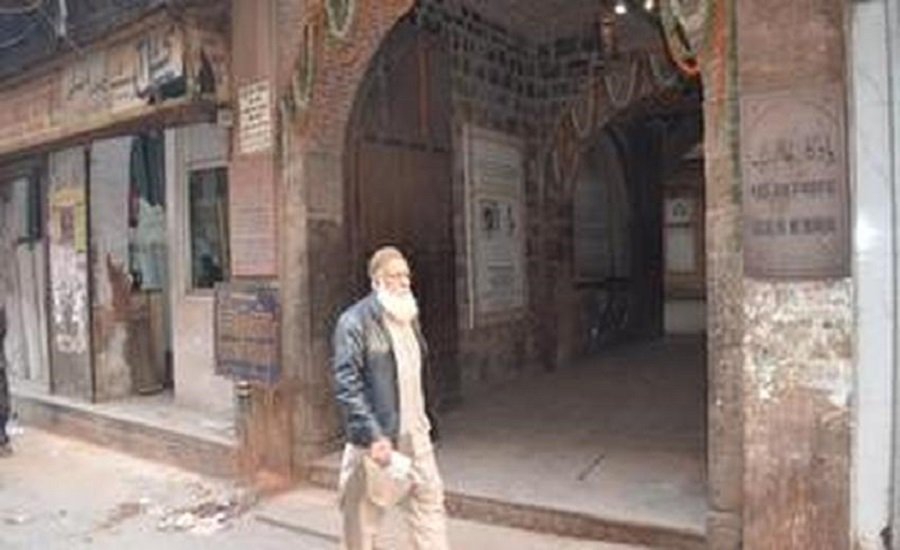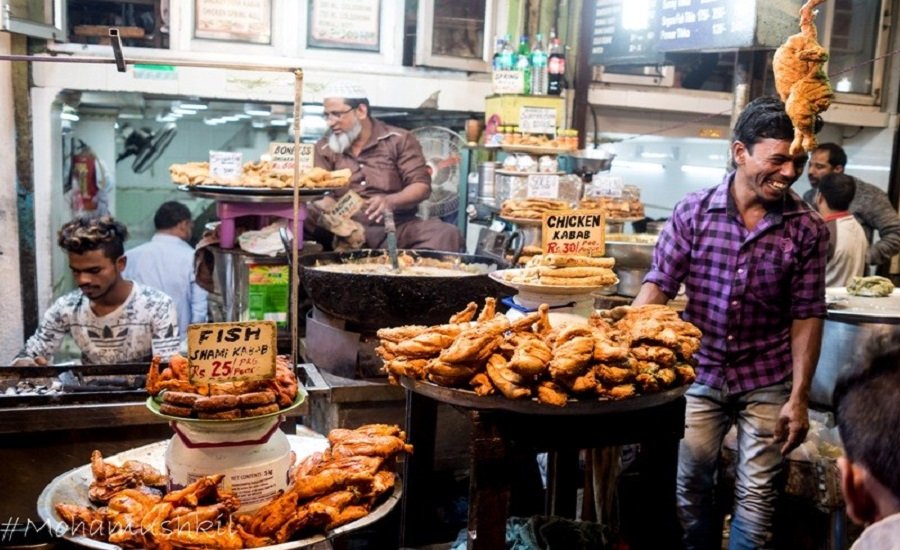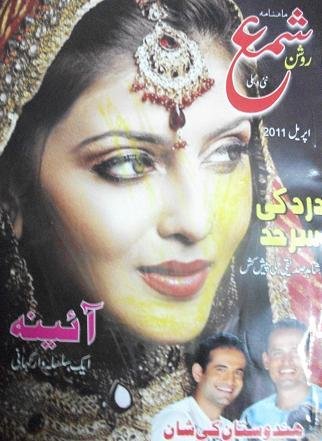
‘Dilli 6’ is now a sanctuary for lower middle-class socialites, who – men and women alike – claim it their birth right to speak on behalf of the Muslims and on the history of Delhi simply because they live in the walled city.
Ather Farouqui
NOT SO LONG AGO, people used to go to the Old City of Delhi called ‘Dill 6’ to buy raw fish and chicken. It was also a favourite destination for those who wanted to purchase books of Urdu fiction or poetry. A major part of the fish and chicken market has now been shifted to Ghazipur. Shops at Urdu Bazar earlier stocking Urdu fiction and poetry now mostly sell Islamic literature and have a turnover in crores in the bargain.
Sale of literary books in the open market is otherwise close to nil. Speeches of Zakir Naik are blaring loudly on the microphone in Urdu Bazar in front of the main gate of Jama Masjid. Delicious and reasonable non-vegetarian food is still available at roadside khaumchas.
The clientele of the expensive restaurants in the area consists mostly of non-Muslims and foreigners. For this reason, the so-called Mughlai dishes bear a heavily Punjabi stamp and are quite mild, mainly in consideration of the tender constitutions of foreign customers. Buffalo meat is invariably mixed, of course with exceptional shrewdness and experience, with mutton in every restaurant of Jama Masjid, irrespective of its reputation.
After crossing Chawri Bazar, a stationery retail market, one reaches Gali Kashmiriyan via Hauz Qazi. The area broadly known as Bazar Sitaram has a Nehru-family connection being where the house – Haksar ki Haveli – of Jawaharlal’s in-laws is situated. Incidentally, Ms Indira Gandhi and, following in her footsteps, her successors in the Nehru-Gandhi clan never took any interest in it despite the fact that Ms Indira Gandhi was very close to her mother.

It was also the home of the late Gulzar Dehlavi (d 12 June, 2020 at Kailash Hospital in Noida), the poet who epitomised the city’s celebrated Ganga Jamuni culture. In the early 1980s, he moved to Kailash Colony and from there to Noida, his penultimate abode where he recently died at the age of 93! For sure Urdu and Dilli will not be able to produce another Gulzar Dehlavi.
These days interest in the history and culture of old Delhi is both academic, in a way it never was before, and fashionable. Historians, literary historians, pseudo historians of social media and the general public with pretensions to learning alike are showing interest in Dilli-e Marhoom or Hazrat-e Dehli.
The Metro has made access to this densely populated area far easier, with a station near the crowded Hauz Qazi Chowk. Just 500 yards away, the Hamdard Dawakhana, facing Qasimjan Street of Ghalib, still operates, but next door the Shama Dawakhana, as it was popularly known for half a century, has no customers. The offices of Shama magazine on Asif Ali Road too have closed down.
Though Shama Dawakhana has acquired a new owner, its ‘modern’ and more ‘scientific’ name, New Shama Unani Laboratories Pvt. Ltd., too has failed to attract customers, at least in Dilli 6. The families running both these establishments used to live in Chanakyapuri at one time, but I have no idea of their present whereabouts except that of the daughter of one with a newly acquired interest in religion and tasawwuf.
The house of the owners of Shama has been purchased by an admirer of Ms Mayawati to gift it to this modern Dalit icon, I am told by a reliable source.
Hamdard is still a name in Unani medicine but infighting in the family gives indication of its future though the family is running Hamdard University by the name of Jamia Hamdard on the lines of a private institution quite well.
Shama Dawakhana and the Shama group of publications, as already stated, have folded up. At one time, the group used to publish a wide variety of magazines. Apart from the eponymous Urdu film magazine, Shama, there was Sushma in Hindi, Bano, a magazine for women, and Khilona for children. Shabistan was a digest loosely on the pattern of Readers Digest and Mujrim a monthly devoted to detective fiction.

Aaina was a magazine different from all other publications of Shama but it never became popular and soon went out of circulation after its ambitious editor Zoe Ansari flew off to Moscow for a few decades – cashing in on his loyalty to the CPI – for earning roubles. He did a number of landmark translations of Russian classics into Urdu before he finally landed in Bombay as professor and head of department of Russian studies and stayed there till his death.
A big chunk of Shama’s revenues used to come, however, from Shama Dawakhana, which used to advertise Viagra-type aphrodisiacs, which it promised to deliver at your doorstep anywhere in the world! All publications of the Shama group, however, were family magazines and were to be seen in every Urdu-speaking Muslim house until the 1980s despite carrying advertisements of such medicines.
Urdu journalism as a whole, in fact, survived on the revenues earned from advertisements of such dispensaries for a long time. Perhaps a family dispute, whose reasons I am completely unaware of, was responsible for the next generation of owners, the Dehlavi brothers, failing to keep in touch with changing times.
Ghalib’s haweli, adjacent to a mosque at Ballimaran, was a coal-selling tall until the 1990s, and is now a museum the way an Urdu poet describes it: Jo Dil ka haal hai wahi Dilli ka haal hai.
Ghalib wouldn’t have minded. After all he said:
Masjid ke zere saya ek ghar bana liya hai; Yeh banda-e kamina humsaya-e Khuda hai
(I have set up home and hearth in the shadow of the mosque and now this wretched creature has become a fellow traveller of the helpless Almighty.)

At least he has not been asked to vacate his penultimate abode, though he would hardly have been interested in making his gosha a national heritage property.
Sanctuary for Muslim Socialites
‘Dilli 6’ is now a sanctuary for lower middle-class socialites, who – men and women alike – claim it their birthright to speak on behalf of the Muslims and on the history of Delhi simply because they live in the walled city. Some of them can speak a little English and they dress differently from the bulk of the ladies of old Delhi.
She had then just started runniing a campaign against the Imam of Jama Masjid, which incidentally helped her get some publicity with police protection as immediate dividends in her adventurous career. Roaming around with a security guard is certainly a status symbol in India in general, and in a Muslim ghetto, it is something of extraordinary importance for psychological reasons of the Muslim mindset which is obsessed with power after losing it in 1857.
She is originally from a lower middle-class family of Uttar Pradesh and has undergone for ordinary basic schooling at primary and secondary level education before she went to one of the worst provincial universities of the state for tertiary education. She has no idea of old Delhi traditions or any sense of history or culture at all, let alone a sense of belongingness.
She is completely blank when it comes to theology too. She does not know any Urdu and can hardly speak English of the kind that can gain her entry into the English-speaking elite of Delhi circles, so chose Hindi for her modus operandi. Belonging to Uttar Pradesh, she was married into an established family of Dilli 6.
We happened to get talking about George Fernandes in the aftermath of the Gujarat riots and I mentioned his estranged wife, Leila Kabir, who had deserted him long back. (A few years before his death, it was reported in the media that the socialist lion of yesteryears had Alzheimer’s and his property of Rs 25 plus crore was up for grabs. At this point she and her son decided to ‘look after him’ and were then locked in an unseemly dispute with his brothers and ‘friend’ Jaya Jaitely who was only interested in George’s political legacy – an admixture of conviction, ideology, opportunism and, of course, shame.)
The lady expressed her ignorance about Leila Kabir. I told her that Leila was Humayun Kabir’s daughter. The lady then asked who Humayun Kabir was. With surprise turning to irritation, I told her that Humayun Kabir was the person with whose help Maulana Abul Kalam Azad had penned India Wins Freedom. The lady’s next query was what India Wins Freedom was all about.
I changed the conversation because it is not considered civil if a woman feels any degree of humiliation in a discussion for whatever reasons. I didn’t want to embarrass her further but the lady felt offended. She then started holding forth on Maulana Azad, the Independence struggle and the establishment of Pakistan. Other people were hesitant, but I mustered the courage to ask her who her source of information was. Confidently, she claimed that the Maulana had shared these insights with Khaalu Fazlu and he, in turn, had passed them on to her before his death when she came to Delhi as a bride.

Everyone wondered who this Khaalu Fazlu was. She disclosed that he was related to her husband and was a peon in the Ministry of External Affairs during the Maulana’s time! ‘But Maulana Azad was Education Minister and not Foreign Minister’, someone, of course not I, ventured to say. ‘How could that be?’ roared the lady.
‘The Maulana established the ICCR, which is under the MEA, and I have benefited from the Indian Council for Cultural Relations (ICCR) in more ways than one.’ She had for years been writing a regular column on Muslims and gender issues for a Hindi monthly…. known for its ‘Hindi-style’ progressivism. Once Taslima Nasreen agreed to write a column, the Old Delhi lady lost out her column to her. She is also a regular visitor to Muslim countries, of course, to speak on Indian Muslim Women.
The lady can occasionally be seen on television debates on Muslims. She used to be quite a regular on Ravish Kumar’s show, holding forth on Muslims and Muslim women in particular, a subject she certainly knows nothing about. More than once I have watched her on a panel with Faizan Mustafa on legal issues related to Muslim women.
It is certainly not the fault of Ravish Kumar but that of his research team. Ravish himself has established his secular, intellectual and humanitarian credentials and must be considered above question. Taking liberties with Majrooh Sultanpuri’s famous couplet to suit the context. Majrooh said:
Dahr mein Majrooh koii javedaa mazmoon kahan; Main jise chhoota gaya wo javedaan banta gaya
(Nothing on earth is imperishable O Majrooh! Yet whatever I touched became imperishable.)
Majrooh was concerned with making any pedestrian idea immortal with his poetic treatment but Ravish’s touch can make any person an intellectual:
Muslimon mein ab koii dana kahan baqi Ravish; main jise chhoota gaya wo nukta daan banta gaya
(Not a single wise man is left among Muslims, O Ravish; But whosoever I touch becomes endowed with wisdom)
To become a Muslim intellectual through India media has always been quite easy. The only prerequisite was that one should be a duffer – also the criterion for being a Congress Muslim leader in the past except for those who were part of the freedom struggle. A lot many people were elevated to ministerial jobs by Ms Indira Gandhi who, on merit, would not have been recruited as clerks even.
____________
Ather Farouqui is the general secretary of Anjuman Taraqqi Urdu (Hind), New Delhi. He is also a scholar of Urdu language, an author and recipient of Sahitya Akademi Award for translations. His most recent publication is titled Delhi in Historical Perspectives (trans., 2020), a translation of essays on the historical and cerebral life of the capital city by medieval Indian historian Professor K.A. Nizami.


